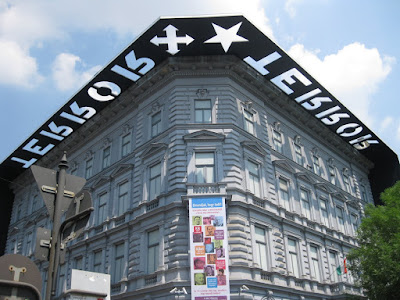
A walk up Andrassy ut, the historic street in Budapest that is a World Heritage Site, past the Opera House to #60, brings you to the Terror Museum. This relatively new museum documents, with chilling authenticity, the brutal atrocities of the Nazis and their Hungarian henchmen from 1944 to the end of World War II, and the takeover of the country by Communist regimes starting with Stalin, going through resistance and the 1956 revolution, and up to 1990, when Hungary became an independent Republic.
60 Andrassy street was Nazi headquarters during the war, then the headquarters of the Hungarian communists, Stalin loyalists, and the dreaded secret service after the war. It was the scene of violence, torture, spying, and executions of thousands of Hungarians. People went in and never came out. Few Hungarian families were unscathed by these regimes. Yale historian Timothy Snyder writes about eastern Europe being caught between Hitler and Stalin in Bloodlands, an amazing history everyone should read.
The young woman who manages the Lavender Circus hostel near the Opera House, Agnes, tells of cousins who were snatched in the night for no reason, tortured, then disappeared. Agnes says that sometimes the fear is still palpable. She is studying for a PhD in English Literature, focusing on Jane Austin, about as far away from politics as you can get. I understand this. Loren would have found it fascinating.

The somber music when you enter the museum, cellos and drums, some contemporary alternative songs beating in other rooms, set the stage and the mood, one of fear and trembling, as do the names and photographs on the outside and inside walls of the museum, a memorial to thousands of victims. It is sobering, like the photos that peered down at us in stunning disbelief at Auschwich, the sound of silence, telling us to remember.
Hungary suffered. There were spies and heroes, collaborators and resisters. It's a tangled web of totalitarianism and terror. The most moving aspects of the exhibits at the Terror Museum are the videos of interned survivors and brave resisters, a fabulous ongoing oral history project that features sensitive in-depth interviews of people telling their stories, spliced with live footage of trials, interrogations, Soviet speechmaking and propaganda, and actual horrors and treatment of prisoners.
It reveals a lot about present-day eastern European countries that they are remembering these atrocities of the past, documenting them for future generations, and opening up once-closed topics for public examination. Deniers still exist, as do ominous stereotypes, evidenced in a rise of neo-Nazis and the graffiti we saw on the white wall of a building as we toured the once-thriving, once-decimated, still extant Jewish community in Krakow (where  Schindler’s List was filmed).
Schindler’s List was filmed).
 Schindler’s List was filmed).
Schindler’s List was filmed).
That's why these museums, memorials, restored buildings, documentary films, and tours led by informed guides are so important. They help counteract the persistence of prejudice and shed light on the dark side of our history. “Those who don’t know their history are doomed to repeat it,” the philosopher Santayana wrote. Will we learn our lessons from the past? Are we doomed to repeat history?




